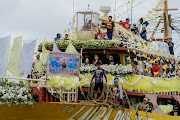Among the churches in Negros Occidental, one stands out with a totally different look. This is not to say that this church is the most handsome of all, it is just different.
One can say this because while every other church is either made of coral stone or brick, and typically structured with the belltower being the dominant feature, the church of St. John the Baptist in Bago City has a different facade in consonance with the history of this city. With Bago known for its role in the Negros Revolution of 1898, one is awed with how the church of St. John the Baptist was providentially shaped as a fortress.
 The neo-Renaissance style facade of the St John the Baptist Church features belvederes, pilasters, and multiple arches articulated by bands of color.
The neo-Renaissance style facade of the St John the Baptist Church features belvederes, pilasters, and multiple arches articulated by bands of color.
From a spiritual standpoint, the church of St. John the Baptist is indeed somewhat of a fortress to the Christian faith in the south of Negros Occidental. It can be recalled that the message of Christianity first arrived in the town of Binalbagan in 1571. From there, one of the first missions out of Binalbagan, the first town to be established on the island of Negros, reached the settlement of Bago, some 46 kilometers to its north.
As early as 1575, the community in Bago was placed under the evangelical visitations of Father Geronimo Marin, the Augustinian priest who had taken charge of the Christianization of the natives of Binalbagan since 1572. Father Marin, upon his arrival in the community, celebrated the feast of St. John the Baptist, who would later be accepted as the patron saint of the place. Thus the foundation of Bago and the parish is dated as June 24, 1575.
As one of the first missions under evangelical visitation, the parish in Bago became a springboard for other missions of the faith in the northern part of Negros Occidental. It was in Bago that more settlers and immigrants from Panay Island came to establish new homes and livelihood. This happened in the 17th century when the descendants of the more prominent names we hear of today immigrated to this town by a big river known today as Bago River.
The church also bore witness to the proclamation of the Negros Republic in November 5, 1898, by General Juan Anacleto Araneta, who together with General Aniceto Lacson of Talisay, led local forces to force the capitulation of the Spanish garrison at Bacolod thus putting an end to the Spanish sovereignty in the province.
 Large arched fenestrations reveal the thick brick walls of the structure.
Large arched fenestrations reveal the thick brick walls of the structure.
The church façade today is a product of many revisions from the early part of the 20th century. Nevertheless, its squarish and fortresslike appearance is an apt representation of the strength of character and faith of the people of Bago. This church of St. John the Baptist is a visual reminder that "God is our refuge and strength, a very present help in trouble."
 The main door of the church is flanked by two large windows, the ensemble crowned by lunettes.
The main door of the church is flanked by two large windows, the ensemble crowned by lunettes.

St John the Baptist, the church’s patron, is shown holding a shell, a symbol of baptism.
Photos by : Ronnie Baldonado
Video by : Grilledcheese Studios
Text by : Lloyd Tronco











